Outforia Quicktake: Key Takeaways
- Starfish stand out in the animal kingdom with their unique ability to reproduce both sexually, by releasing eggs and sperm into the water, and asexually, by self-cloning through detaching pieces of their bodies.
- Not all starfish reproduce without a mate, but those that do have two ways to do it: fissiparity, in which they split in half, and autonomy, in which a body part that falls off grows back into a new starfish.
- Starfish are “broadcast spawners,” which means they release eggs and sperm all at once.
- Despite the shared reproductive methods, the crown of thorns starfish boasts a nearly perfect success rate in fertilization – a rarity among starfish. This starfish can release approximately 50 million eggs in one session.
- Starfish have the ability to regenerate lost limbs, and this ability goes hand-in-hand with asexual reproduction. If a starfish breaks into several pieces, each piece can regenerate and become a new genetic clone.
Sea stars are lovable creatures with alien-like movements. They use their long arms and tube feet to crawl across the sea floor and hunt for food. Besides their unique appearance and habits, starfish have a unique way of reproducing.
Starfish can reproduce sexually or asexually. Most species reproduce sexually by releasing sperm and eggs into the water for fertilization. Most can also cut off pieces of their bodies to create identical clones of themselves.
How Do Starfish Reproduce?
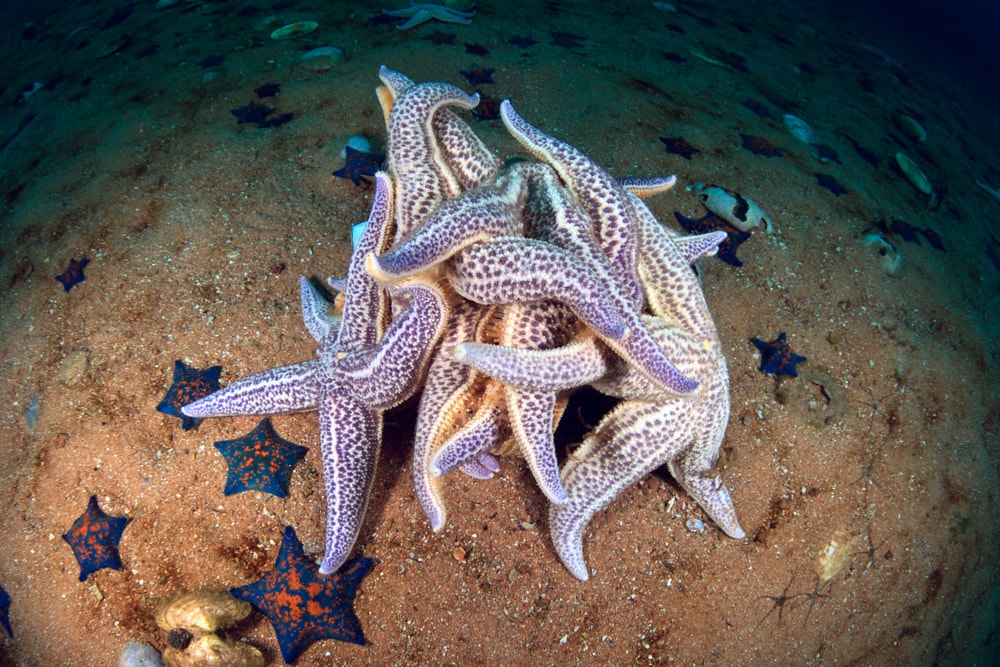
Starfish can reproduce both sexually and asexually. Sexual reproduction is the most complicated method.
How a sea star reproduces depends on its species and its environment.
1. Spawning
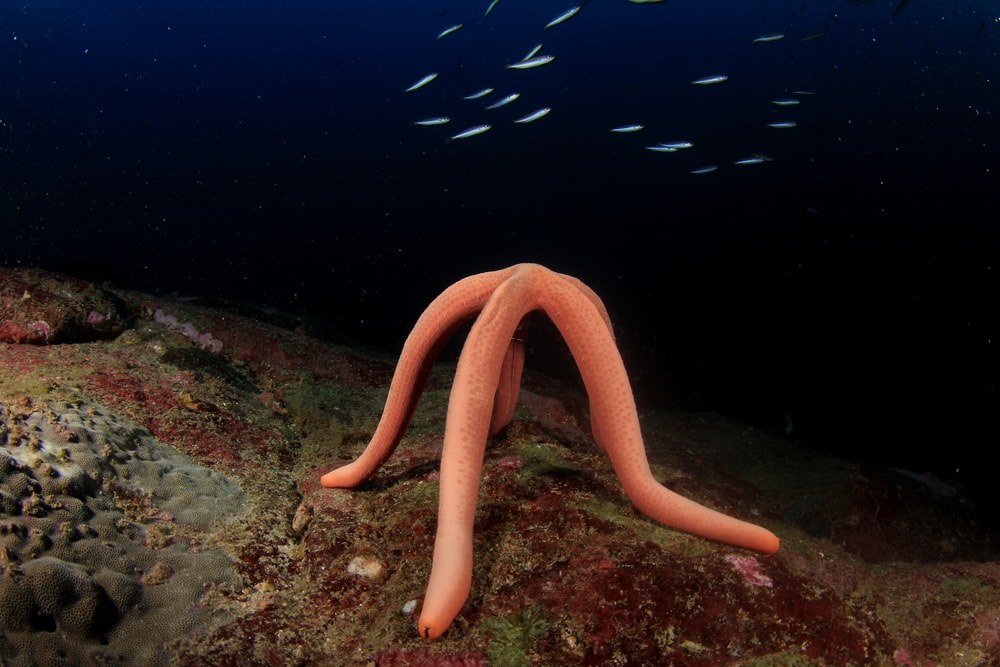
Starfish are “broadcast” spawners. They release eggs and sperm into the water column for fertilization.
During spawning, many starfish gather together in aggregates. They release eggs and sperm en masse into the water column. Female starfish can release millions of eggs into the water simultaneously.
Most starfish species are gonochoristic, meaning they have separate sexes. A few species are hermaphroditic.
A starfish’s sexual organs are “gonads,” and they usually have two in each arm. At the beginning of the mating season, the males’ gonads fill with sperm and the females’ fill with eggs.
A gonophore opening leads from the gonads to the oral surface as a means for the animal to release its eggs or sperm.
The age at which a starfish becomes sexually mature depends on the species. Most become sexually mature around two years of age.
2. Eggs
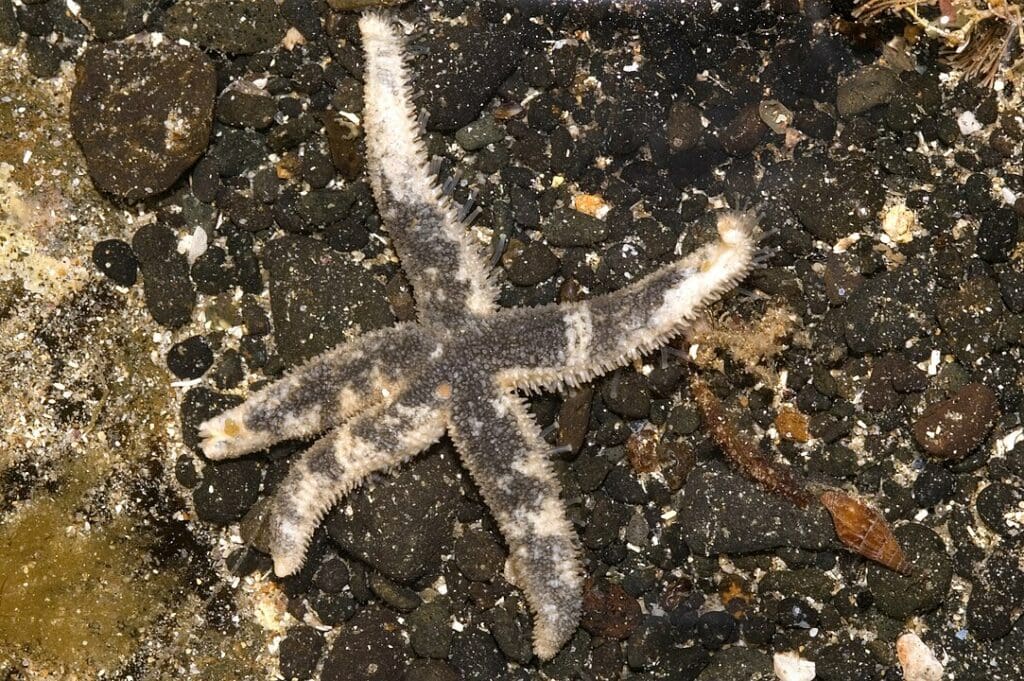
Some starfish watch over their eggs as they develop, while others don’t.
Those that brood over their eggs may lay overtop of them. Others carry them inside special brooding pouches. The pouches may attach to the starfish’s central disk or between the arms.
Brooding is more common among hermaphroditic species, which generally live in harsh environments. The eggs may not be able to survive without the parent there to protect them.
3. Larvae
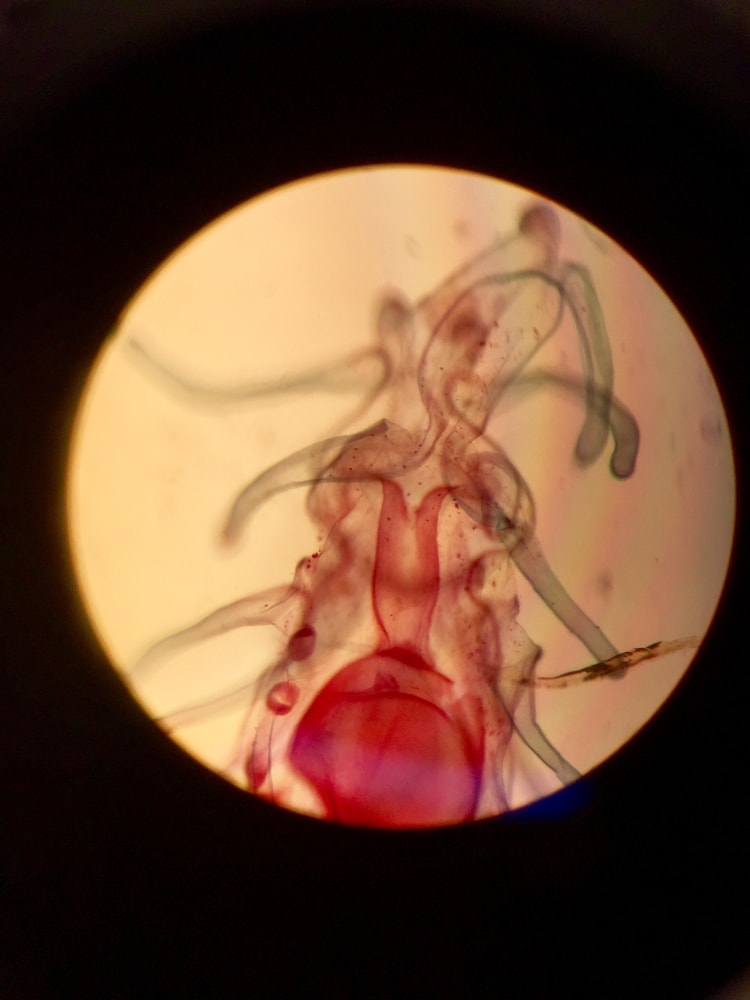
After hatching, the fertilized embryos take on a free-swimming larval form.
Larval starfish have bilateral symmetry. This means they have symmetry on both sides of their bodies. Adults have radial symmetry, which means they are symmetrical all the way around.
Sea stars will shift through several larval forms before metamorphosing into juveniles. It can take several months for starfish to become juveniles. We refer to the larvae as “zooplankton” because they drift through the water.
4. Juveniles

Starfish larvae go through metamorphosis and fall to the bottom of the ocean. From there, they attach themselves to a sturdy surface and slowly grow into adults.
Adult Pheromones Attract Juveniles
Researchers believe that adult pheromones likely attract larvae. Starfish larvae tend to choose spots near adults of the same species. Their attraction is likely due to the adults’ pheromones.
Researchers also suggest that the presence of adult pheromones may trigger metamorphosis in larvae.
Juvenile starfish are vulnerable. They spend most of their time hiding under rocks and inside crevices. As they get larger, they become bolder, coming out to explore for food.
5. Asexual Reproduction
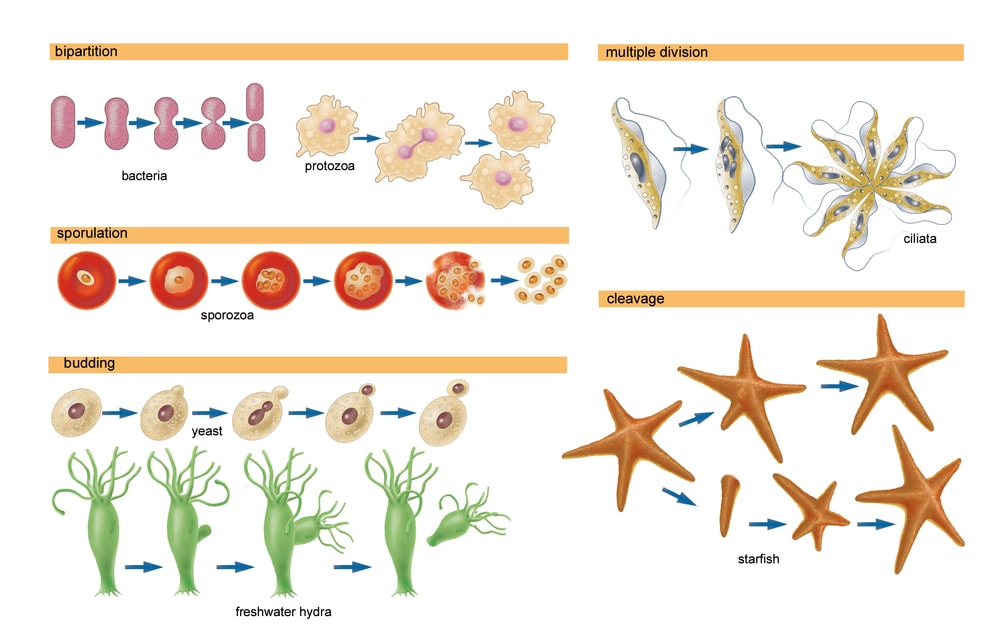
Asexual reproduction means that a starfish can reproduce itself. The use of sperm or eggs is unnecessary. When an animal reproduces asexually, it creates a genetic clone of itself.
Not all starfish can reproduce asexually. It’s far less common than sexual reproduction.
There are two ways that starfish can reproduce asexually: fissiparity and autonomy.
With fissiparity, sea stars cut themselves in half along their central disk.
There are three genera of starfish that reproduce using fissiparity:
- Coscinasterias
- Sclerasterias
- Stephanasterias
In autonomy, a starfish releases one of its arms or part of its central disk. The detached part of the body regrows into a new starfish.
Before we knew about asexual reproduction, people would try to kill sea stars by chopping them up. Researchers once tried to kill crown of thorn sea stars this way. Their populations were overtaking the Great Barrier Reef. Needless to say, the researchers were unsuccessful in using this method.
You May Also Like: How Do Eels Reproduce? The Mystery Of Eel Sex Explained
The Crown Of Thorns Starfish Produces 50 Million Eggs
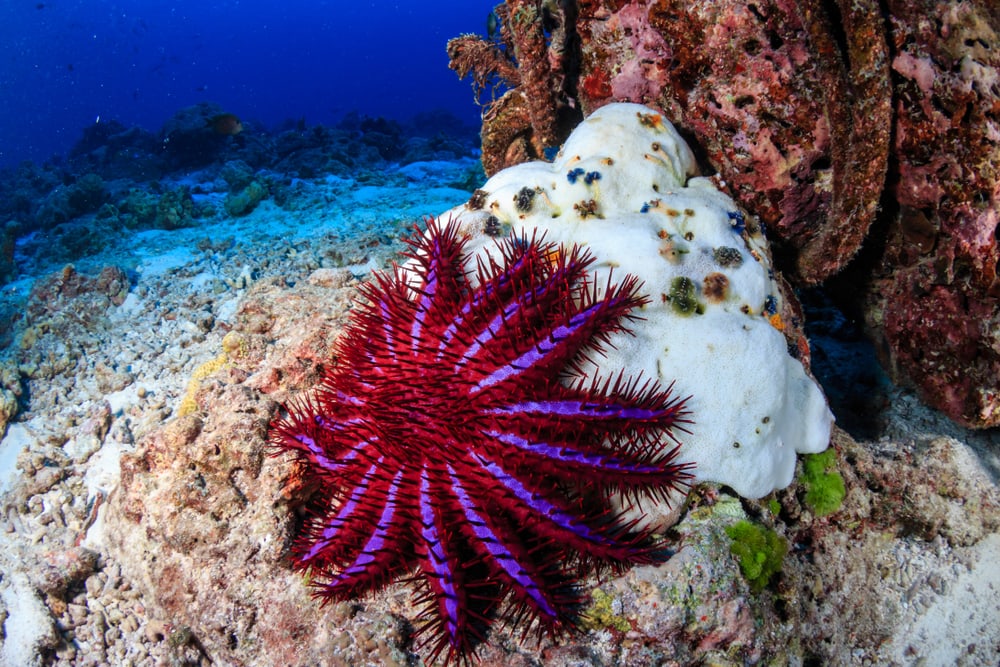
The crown of thorns starfish is one of the largest starfish in the world. Its body can be more than 20 inches (50 cm) in diameter, and it can have over 15 arms.
The starfish gets its name from the many long, sharp spines that protrude from the surface of its body. These formidable spines even contain toxins that keep predators at bay.
Near 100% Fertilization Rates
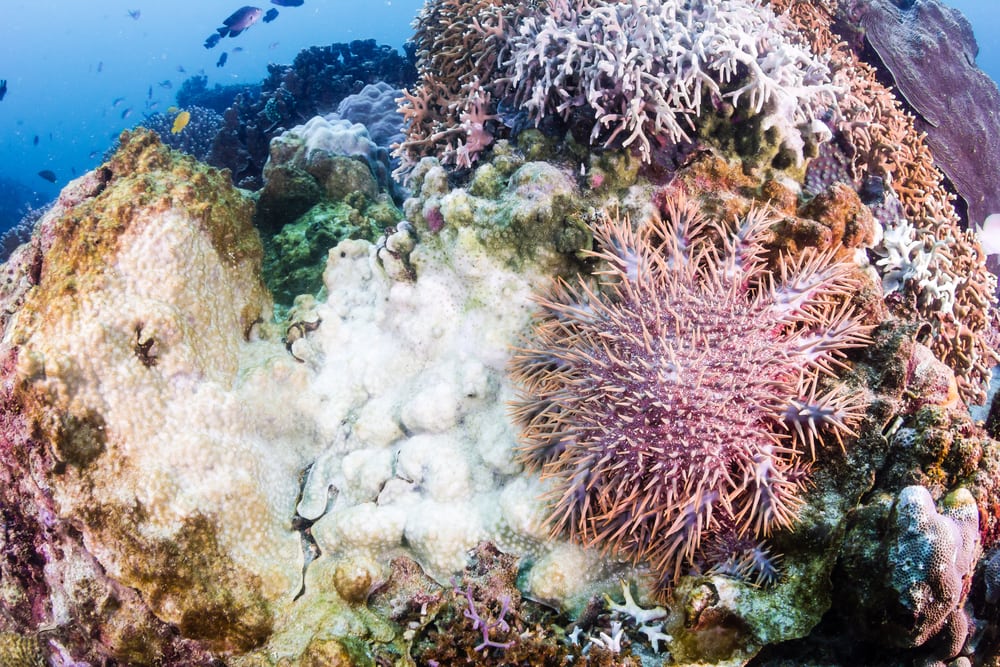
Crown of thorns starfish are also unique for their successful reproduction rates.
For most starfish, spawning is not highly successful. Imagine that they release a mass of eggs and sperm into the water and hope for the best. Many of the eggs drift away, so fertilization never happens.
The opposite is true for the crown of thorns starfish.
Crown of thorn starfish have an almost 100% success rate for fertilization. Yet they reproduce the same way as other starfish, so what makes them different?
The surface of their bodies is soft, unlike most starfish. The softness allows for more flexibility and the production of more eggs.
Their gonads swell to enormous sizes, allowing them to release around 50 million eggs in one go. Plus, they only use about 45% of their energy while creating the eggs.
Crown of thorn starfish spawn in large aggregates when the water temperature is 82.4°F (28°C), and they release sexual pheromones. These cues, along with the sheer number of eggs, allow for nearly 100% fertilization.
Regeneration VS Asexual Reproduction
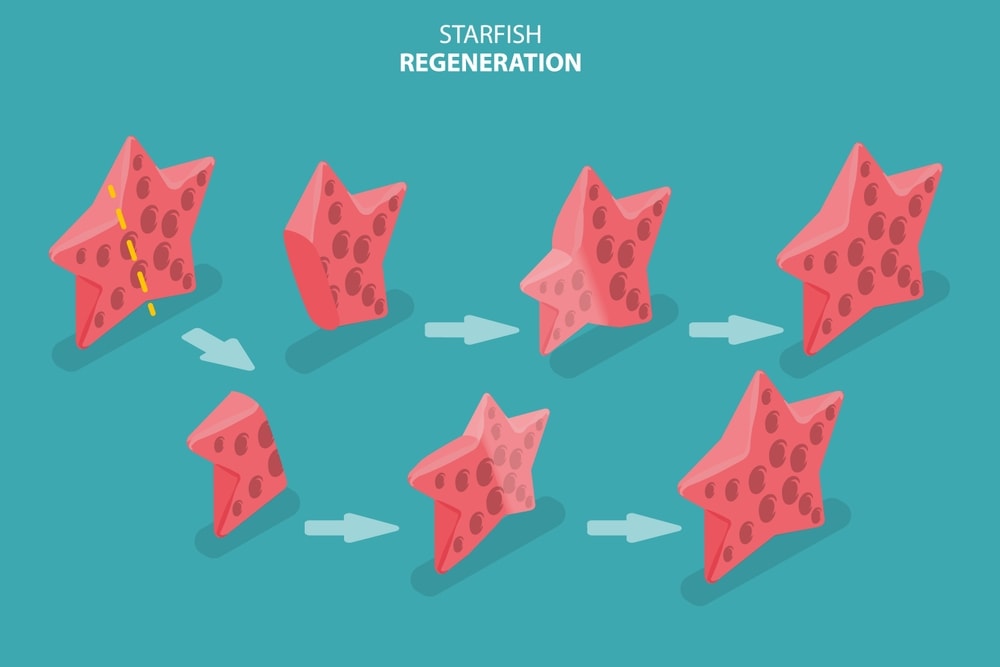
Starfish can be hard to kill because if they lose one of their arms, they simply grow it back.
Yes, starfish have the ability to regenerate, in which case they can regrow damaged arms and tube feet.
To regenerate, most starfish must still have part of their centralized disk. So, to truly kill a starfish, one usually needs to destroy the entire centralized disk.
There are a few species that don’t need their centralized disk to regrow. They only need a part of a severed limb.
Regeneration and Sexual Reproduction
Regeneration goes hand-in-hand with asexual reproduction. If a starfish breaks into several pieces, it can regenerate and asexually reproduce. One piece regenerates into the original starfish. The other pieces become new genetic clones of their parents.
Regeneration takes a long time and can leave starfish vulnerable to predators. The larger the starfish, the longer it takes them to regrow their limbs. The largest starfish may need a year to regrow their lost limbs.
You May Also Like: How Do Whales Mate And Reproduce? Sex Underwater Explained
What Are Starfish?
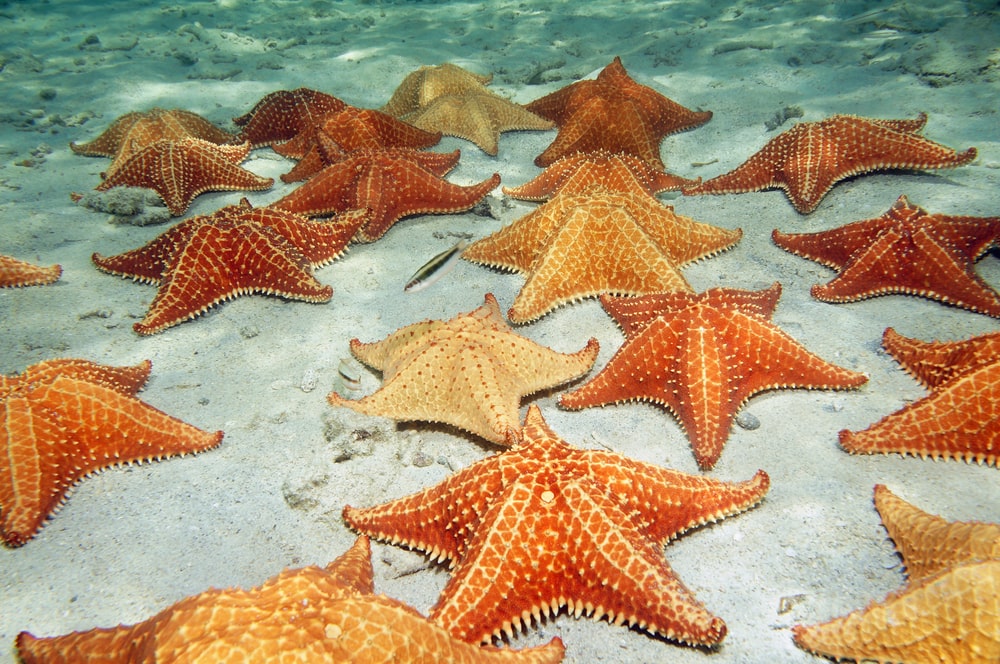
Starfish (Asteroidea) are echinoderms. They are a type of animal that has five points of symmetry. They are relatives of invertebrates like sea cucumbers, sea urchins, and sand dollars.
We sometimes refer to starfish as sea stars. The name “starfish” can be confusing since these animals aren’t fish.
Sea stars are also characterized by having tube feet. Tube feet are tiny, suctioning appendages that starfish use to move and eat. Besides that, they have a central disk and many legs.
There are 500 genera of starfish, comprising over 1,800 species.
Sea stars do not have a centralized brain like other animals. They cannot think but are able to respond to certain stimuli. Their nervous system allows them to sense light, temperature, touch, and chemicals. It also tells them their orientation within the water.
Where Do Starfish Live?
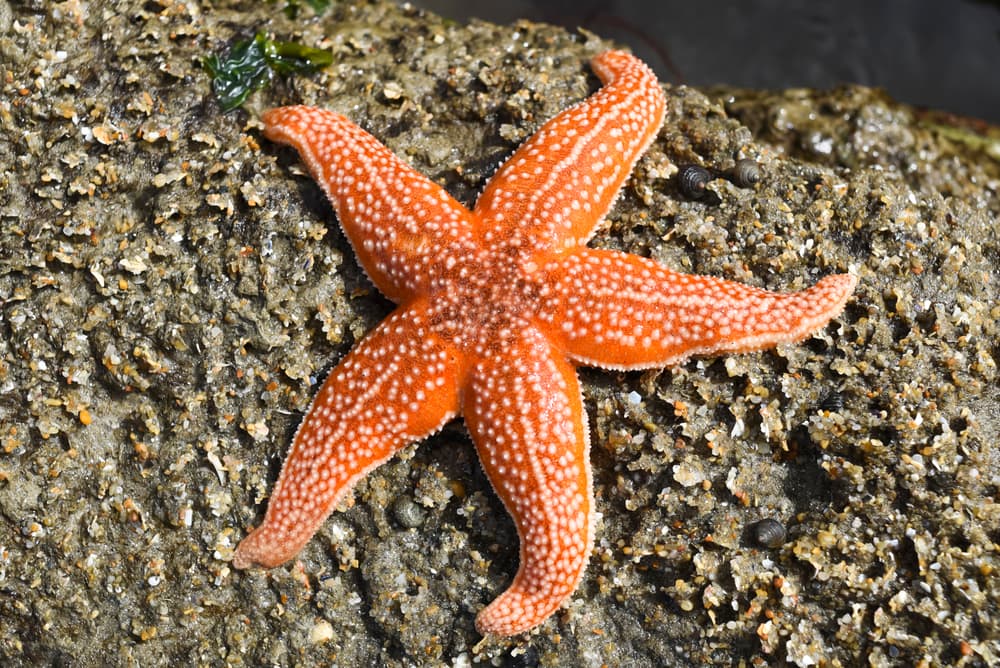
With thousands of species, starfish live in various environments worldwide.
The vast majority of starfish are marine species, and there are species in every major ocean. There are a few sea stars that live in brackish water; freshwater starfish don’t exist.
Some live in the shallow coastal waters of coral reefs. Others live in the deep ocean, where the water is frigid at depths greater than 3.7 miles (6 km).
Regardless of where they live, all starfish are benthic. This means that they live at the bottom of the ocean, crawling across the substrate.
How Big Do Starfish Get?
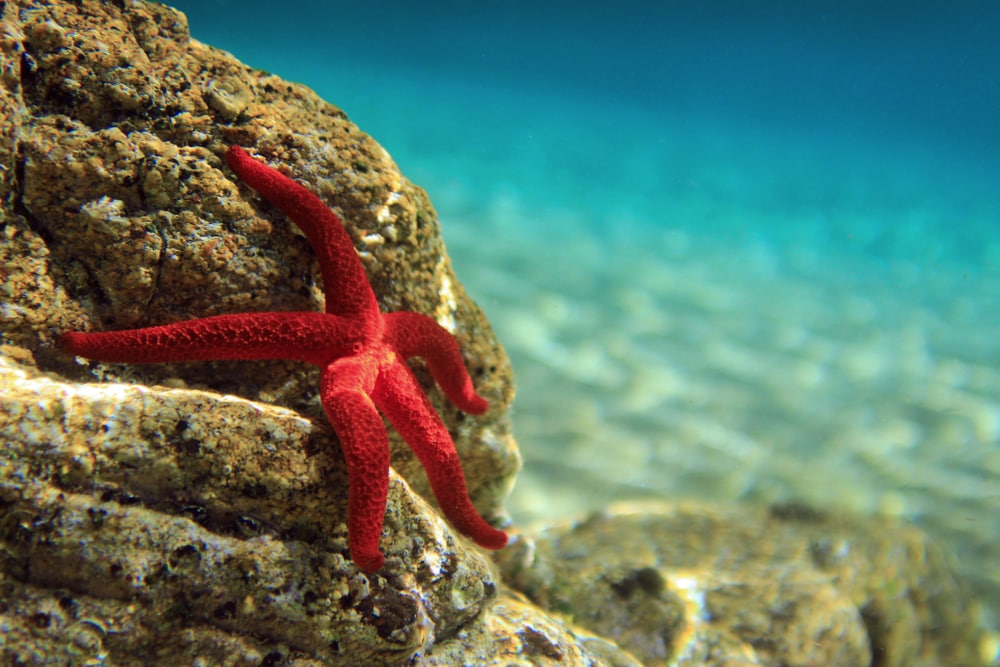
With thousands of species, starfish range greatly in size. The smallest starfish may only be 0.5 in (12.7 mm) in diameter, while the largest can have a diameter of more than 40 in (101.6cm). Most starfish fall somewhere between 4.7-9.4 in (12-24 cm).
Sea Star Skeletons
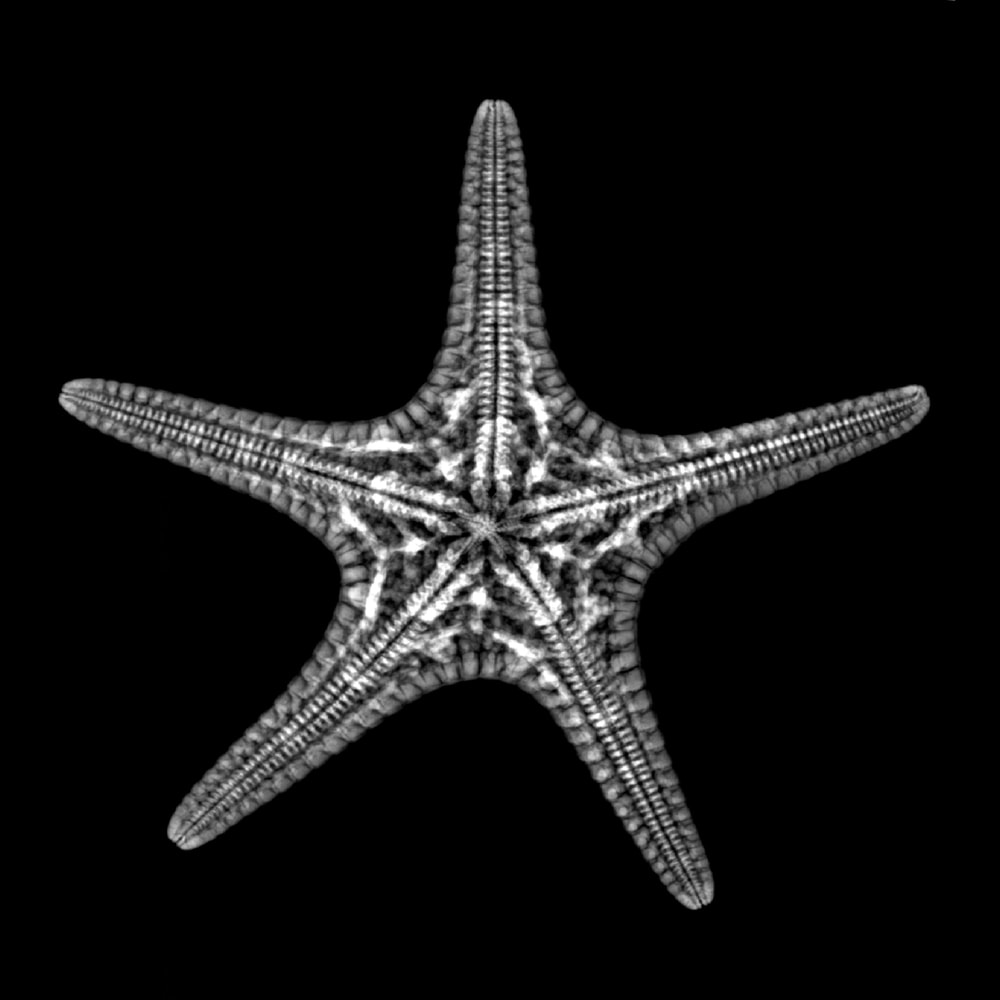
Starfish do not have bones like mammals and most fish do. Instead, their internal skeleton comprises boney plates made from calcium carbonate. Granules and spines cover these boney plates, and a layer of skin covers the entire structure.
Starfish Move Using “Tube Feet”
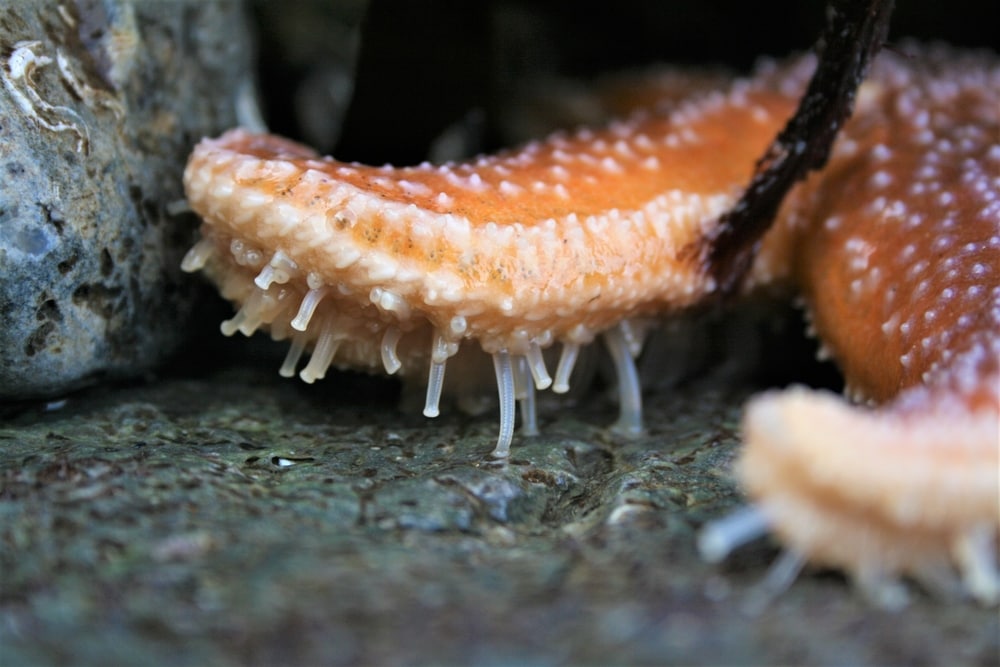
Although sea stars have large, leg-like appendages, they don’t use them to walk. Instead, they have miniature “tube feet” that they use for movement. The tube feet are suction-like appendages on the underside of the starfish’s body. They use the tube feet to grab onto things for movement and eating.
Starfish that live on soft-bottomed substrates tend to have pointed tube feet. They don’t have the suction-cup-like tube feet that most starfish have.
Starfish have a madreporite—a sieve—that they use to pull seawater into their bodies. Then, they use their water vascular system to operate their tube feet.
The water vascular system propels their feet along. There are cilia—hair-like, vibrating structures—inside the water vascular system. The cilia move the water along.
The madreporite sits at the center of the body and comprises a perforated opening. The madreporite leads to a stone canal inside the starfish’s body.
The stone canal attaches to a ring canal that leads to radial canals. The radial canals are inside the starfish’s arms. There may be five or more, depending on how many arms the creature has. At the end of each radial canal is a tube foot.
The ring canal has “Tiedemann’s bodies” and “polian vesicles.” The body uses these for osmoregulation. Osmoregulation refers to the concentration of water and salt in the body.
Starfish also perform most of their respiration through their tube feet during movement.
Starfish Can Sense Things Around Them

Sea stars have non-centralized nervous systems. These types of nervous systems allow animals to sense certain things. They can sense light, currents, chemicals, and touch. Starfish have sensory cells on their skin, but most exist in the tube feet and along the feeding canal.
Starfish can even “see” with “red pigmented eye spots” that exist on the end of each arm. The eye spots are photoreceptors that can sense light.
Starfish Are Carnivores
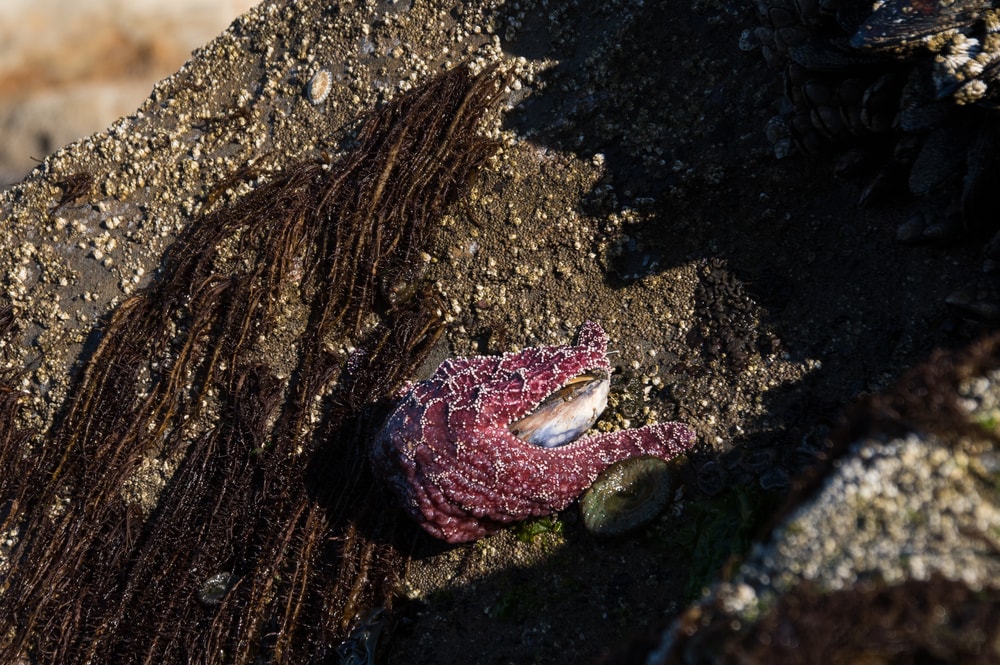
Sea stars are carnivores that can be quite ruthless with their feeding. Many starfish are formidable predators. They hunt for animals that cannot move or are slower than them.
They use their sticky tube feet to grasp their prey and move it to their mouths. Some species use their tube feet during hunting. They can extend their tube feet into the sand or mud to grab whatever animal may be hiding beneath.
Some of the starfish’s favorite foods include:
- Clams
- Coral Polyps
- Fish (injured or dying)
- Mussels
- Oysters
- Other starfish
- Plankton
- Snails
- Sponges
Once they have their prey, many species use their water vascular system to kill the animal. The system is strong enough to pry open bivalve shells to get to the soft flesh beneath.
Then, they push their first stomach outside of their body and into the shell. Using acids from their stomach, they’re able to digest their prey. Then they pull their stomachs back inside their bodies.
Some species are scavenging detritivores rather than predators. They scour the landscape looking for decomposing material from plants and animals.
Others are suspension feeders with mucus on the surface of their bodies. Plankton and detritus stick to the mucus, and the starfish’s cilia move the food to their mouth.
The Lifespan Of Sea Stars
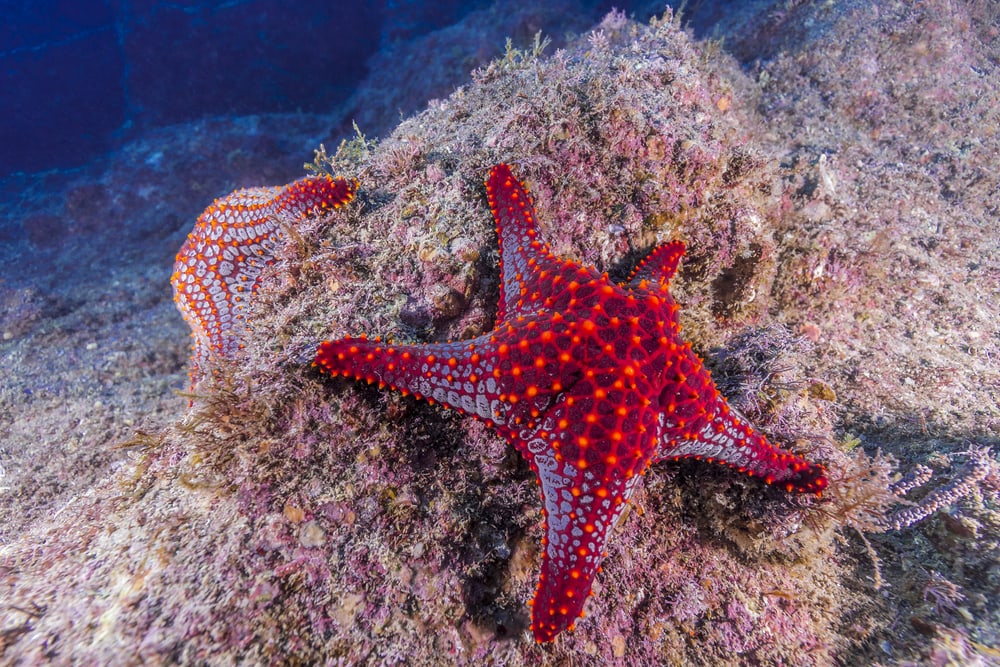
Some starfish species can live upwards of 30 years.
Starfish Predators

Sea stars don’t have many predators. Calcified skin that is almost as hard as bone covers their bodies and protects them. The colors of their bodies also offer camouflage to keep them hidden.
Yet their hard skin doesn’t keep every predator at bay.
Large fish, snails, crabs, shrimp, otters, sea turtles, birds, and starfish are predators.
Predators that are large enough will simply eat the sea star whole. They never have to worry about penetrating the hard skin. Smaller predators attack by flipping the starfish over and eating its soft underbelly.
You May Also Like: How Do Snakes Mate? An Exploration Of Their Unique Reproductive Methods
How Do Starfish Reproduce FAQs
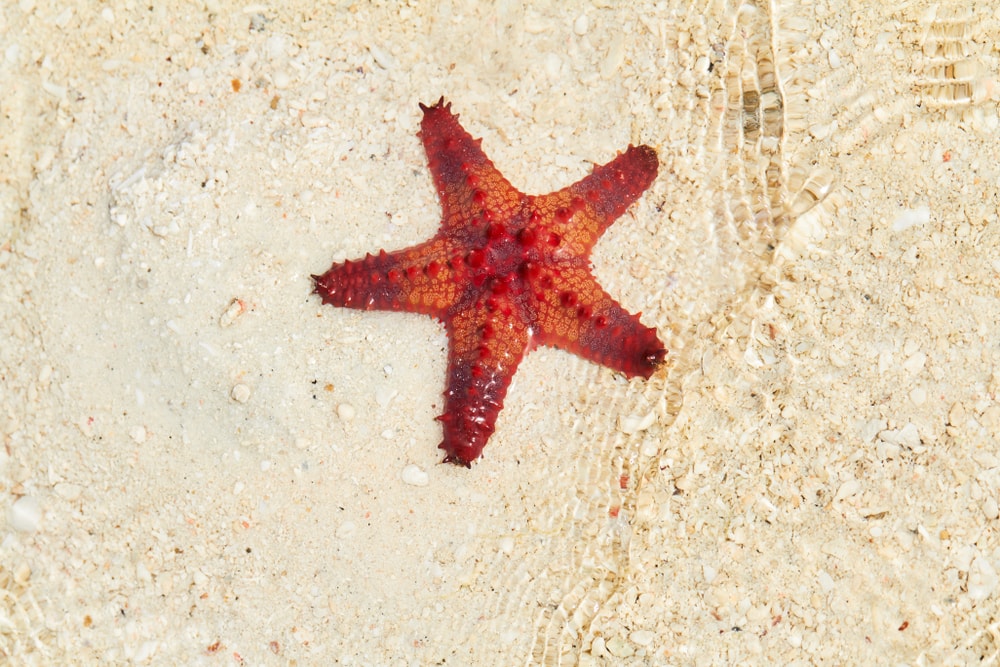
Are Starfish Fish?
Starfish are not really fish; that’s why we often refer to them as “sea stars” instead.
Unlike fish, starfish do not have gills, fins, or scales. Their bodies do not even contain blood. Instead, they have a “water vascular system.” A starfish’s body uses seawater inside it to move nutrients through it.
Do All Starfish Have Five Legs?
While most starfish have five legs, some species have more. The Antarctic sun starfish, for example, has 40 to 50 arms.
Here are a few other examples:
– Midgardia xandaros—12 arms
– Sunflower sea star—up to 24 arms
– Stimpson’s sun star—up to 12 arms
Do Starfish Have Eyes?
Most starfish have a primitive eyespot at the tip of each arm that allows them to sense light. Their eyes have several lenses called “ommatidia.” Each eye creates a single pixel that allows the animal to see.
Some tropical starfish can even see rough images that allow them to stay within their home range.
Research shows that deep-sea starfish can see images despite there being no light.








